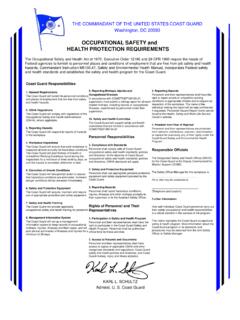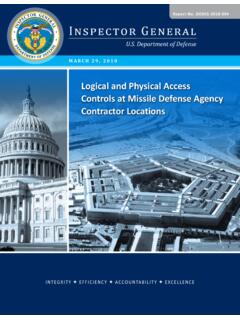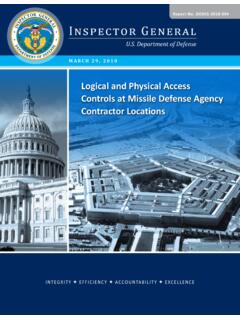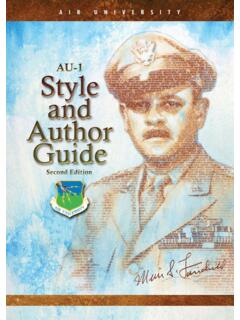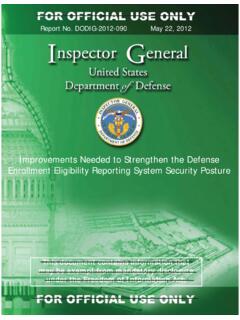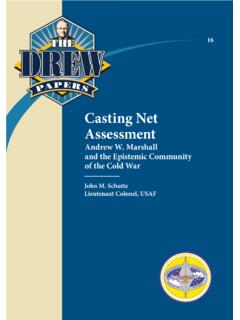Transcription of NAVY LEader Development Framework
1 NAVY LEader DevelopmentFrameworkMay 2019 Version 1 CHIEF OF NAVAL OPERATIONSA pril 6, 2018 The Charge of CommandRef: (a) 10 5947 (b) Navy Regulations (1990)Encl: (1) ADM Ernest King CINCLANT Serial 053 of January 21, 1941 (2) Hobson s Choice (Wall Street Journal, 1952)The Privilege of Command1. As a prospective or serving Commander or Commanding Officer, you have been identified as worthy of the privilege of command. The decision to select you for command was not made lightly; you were selected based on your demonstrated past performance and the trust and confidence that senior Navy officers have in you to lead Sailors under your charge.
2 2. Command is the foundation upon which our Navy rests. Authority, responsibility, accountability, and expertise are four essential principles at the heart of command. Effective command is at risk if any of these principles is lacking or out of You accept the extraordinary responsibility of command with full regard for its consequences. It is the duty of every Commanding Officer to understand his or her authorities and responsibilities prior to assuming command, which are clearly laid out in statute and regulations as outlined below.
3 The Scope of Command1. All Commanding Officers and others in authority in the naval service are required to show in themselves a good example of virtue, honor, patriotism, and subordination; to be vigilant in inspecting the conduct of all persons who are placed under their command; to guard against and suppress all dissolute and immoral practices, and to correct, according to the laws and regulations of the Navy, all persons who are guilty of them; and to take all necessary and proper measures, under the laws, regulations, and customs of the naval service, to promote and safeguard the morale, the physical well-being, and the general welfare of the officers and enlisted persons under their command or charge.
4 (Ref (a))2. Commanders shall be responsible for the satisfactory accomplishment of the mission and duties assigned to their commands. Their authority shall be commensurate with their responsibilities. Normally, commanders shall exercise authority through their immediate subordinate commanders. (Ref (b), Paragraph 0702)3. The responsibility of the Commanding Officer for his or her command is absolute, except when, and to the extent to which, he or she has been relieved therefrom by competent authority, or as provided otherwise in these regulations.
5 The authority of the Commanding Officer is commensurate with his or her responsibility. While the Commanding Officer may, at his or her discretion, and when not contrary to law or regulations, delegate authority to subordinates for the execution of details, such delegation of authority shall in no way relieve the commanding officer of continued responsibility for the safety, well-being and efficiency of the entire command. (Ref (b), Paragraph 0802)The Standards of Command1. There are two standards to measure officers in command.
6 The first is the standard for criminal behavior, which should be well known to you. The second and higher standard is trust and confidence, both with the American people we are sworn to protect and across all levels of the A Commander s competence and character lead to trust and confidence. Commanders can only feel comfortable delegating their authority sending subordinate Commanding Officers and their teams over the horizon and into harm s way with the knowledge that those CO s are both technically competent and share their values.
7 If so, their teams will win performing at or near their theoretical limits and they will always come back stronger than when they left. 3. Trust and confidence are the two coins of the realm that enable decentralized command and operations at sea; they are the key to our effectiveness as a force. Work hard to build and guard trust and RICHARDSONA dmiral, Navy1 INTRODUCTIONThe Design for Maintaining Maritime Superiority, Version (Design ) makes clear that our Navy faces a competitive security environment unlike the past 25 years.
8 Prevailing in an environment with this pace and complexity demands agility and urgency. It also demands maximum performance from our most important asset: our Sailors. In support of Design , we will be a dominant naval force, composed of outstanding leaders and teams, armed with the best equipment, that learns and adapts faster than our rivals. Every person and every unit in the Navy will maximize their potential and be ready for decisive combat operations. To win, our leaders must enable our teams to think more clearly, learn more rapidly, and make better decisions more quickly and more accurately than our adversaries.
9 We must create opportunities to become better leaders and to make our teams stronger. We must be engaged leaders laser-focused on building winning people and teams. As effective Navy leaders , we must demonstrate a deliberate commitment to grow personally and professionally throughout our careers. We work from a foundation of humility, embracing our core values of honor, courage, and commitment. We pursue excellence in accordance with our core attributes of integrity, accountability, initiative, and toughness.
10 We commit to improving competence, character, and connections in ourselves and in our teams. We set ambitious goals and then inspire our teams to achieve the best possible performance . Serving as a LEader in America s Navy requires a dedicated and coherent approach that starts on day one and continues throughout our careers. The Navy Leadership Development Framework describes how to achieve this LEader Development Navy Leadership Development Framework is being updated to Version for two key reasons: First, the Design for Maintaining Maritime Superiority has been updated to Version Design contains bold and ambitious new goals, including goals that affect LEader Development .
